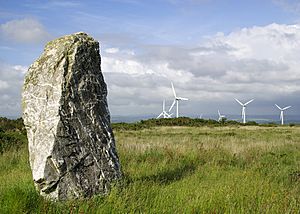St Breock Downs Monolith facts for kids
|
Men Gurta
|
|

St Breock Downs Monolith
|
|
| Alternative name | St Breock Longstone |
|---|---|
| Location | near St Breock |
| Region | Cornwall, England |
| Coordinates | 50°28′45.54″N 4°51′56.28″W / 50.4793167°N 4.8656333°W |
| Type | Standing stone (megalith) |
| History | |
| Material | Shale |
| Periods | Late Neolithic / Early Bronze Age |
| Site notes | |
| Public access | Yes |
The St Breock Downs Monolith is a giant, ancient stone in Cornwall, England. People also call it the St Breock Longstone. In the Cornish language, its name is Men Gurta. This huge stone is the biggest and heaviest prehistoric standing stone in Cornwall. You can find it standing tall on top of St Breock Downs.
Contents
What is the St Breock Downs Monolith?
This amazing stone is a type of megalith. A megalith is a very large stone that was used to build a structure or monument. This one is made from a local rock called shale. It has cool patterns of white rock called feldspar veins.
Scientists think the stone weighs about 16.5 tonnes. That's like weighing 16 small cars! It is 4.92 metres long. About 3 metres of it stands above the ground. The stone sits on a low mound of smaller stones. This mound is about 10 metres wide.
When was the Monolith made?
Experts believe this giant stone was put there a very long time ago. It was likely placed during the Late Neolithic period. This is also known as the New Stone Age. Or it could be from the Early Bronze Age.
These periods were between 2500 and 1500 BC. That means the stone is over 4,000 years old! It has stood on St Breock Downs for many centuries.
The Monolith's History
The St Breock Downs Monolith has not always stood upright. In 1945, it fell over. But don't worry, it was put back up in 1956! Before they re-erected it, a small team did some digging. This is called an excavation.
They found that the stone had stood on a bed of shiny quartz pebbles. Underneath these pebbles, there were two small hollows. At other ancient sites, similar hollows have sometimes held human bones or ashes. This suggests they might have been part of ancient burial rituals.
Other Ancient Sites Nearby
The St Breock Downs Monolith might have been part of a bigger ancient area. There are other Bronze Age monuments nearby. These include another standing stone. There are also many ancient burial mounds called barrows. These barrows stretch for about 7 kilometres to the west.
Who looks after the Monolith?
People have known about this stone for a very long time. It was first written about in old records in 1613. For many years, it was used as a marker. It helped show the boundary of the St Breock parish.
Today, the site is cared for by the Cornwall Heritage Trust. They look after it for English Heritage. These groups help protect important historical places. They make sure we can all learn from and enjoy them.

